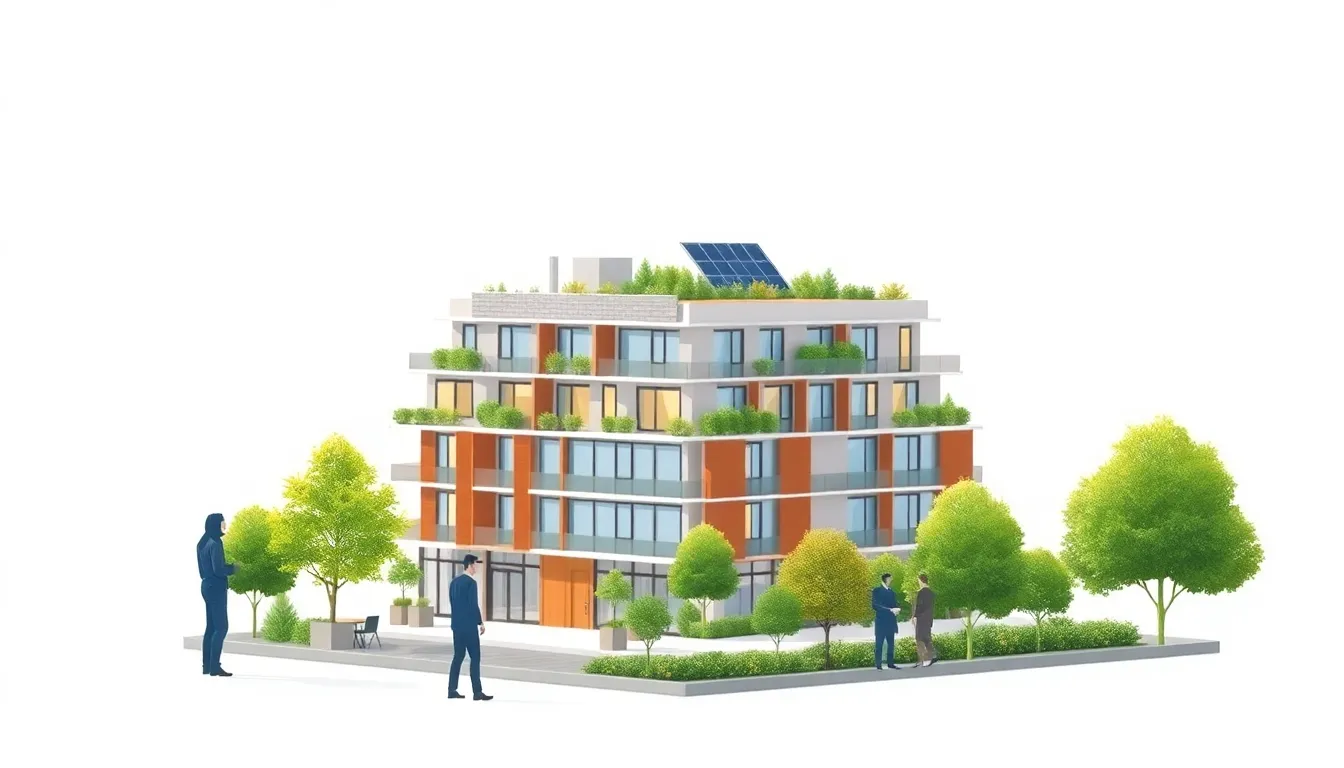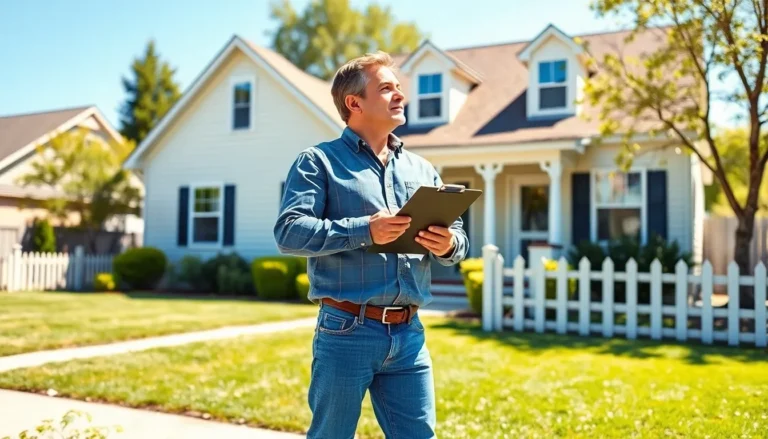As the world grapples with climate change, real estate is stepping up to the plate, trading in its old habits for greener pastures. Gone are the days when a shiny new building was enough to impress buyers. Now, it’s all about sustainability. From energy-efficient designs to eco-friendly materials, the latest trends are proving that going green isn’t just a fad—it’s a necessity.
Imagine a world where homes not only look good but also help save the planet. That’s the reality today as developers embrace innovative practices that reduce carbon footprints and increase property values. So, whether you’re a buyer, seller, or just a curious onlooker, it’s time to dive into the fascinating world of real estate sustainability trends. Let’s explore how these changes are transforming the market and making Mother Earth a little happier, one building at a time.
Table of Contents
ToggleOverview of Real Estate Sustainability Trends
The real estate sector prioritizes sustainability as a core strategy. Energy-efficient designs enhance overall building performance. Utilizing eco-friendly materials reduces environmental impact, making new developments more desirable. Smart technology integration in properties allows for optimized energy management, leading to reduced utility costs.
In urban planning, mixed-use developments promote walkability and lower carbon footprints. Green building certifications like LEED encourage developers to adopt sustainable practices. Developers now prioritize renewable energy sources such as solar panels and wind turbines to power their projects.
Property value increases often correlate with sustainable features, attracting environmentally-conscious buyers. Market research consistently indicates growing demand for sustainable homes. Investors are recognizing the long-term financial benefits of eco-friendly investments.
Sustainable landscaping practices create aesthetically pleasing environments while preserving biodiversity. Adoption of water-efficient fixtures and rainwater harvesting systems significantly reduces water consumption.
Government regulations are also shaping sustainability practices, as many municipalities implement stricter codes for energy efficiency. Developers must adapt to these requirements to stay competitive and compliant.
Overall, the convergence of technology, consumer demand, and regulatory changes drives the momentum toward sustainability in real estate.
Key Drivers of Sustainability in Real Estate

Sustainability in real estate stems from various key drivers influencing the industry. Government regulations and consumer demand play significant roles in shaping sustainable practices.
Government Regulations
Stricter energy efficiency codes compel developers to innovate. Many local and federal policies mandate sustainable building practices, enhancing environmental responsibility. Compliance with regulations often requires the integration of renewable energy sources and energy-efficient designs into new structures. Financial incentives encourage these initiatives by reducing costs for developers investing in sustainable technologies. Regulatory frameworks promote transparency, holding developers accountable for their environmental impact. As a result, sustainability becomes essential for maintaining competitiveness in the market.
Consumer Demand
An increasing number of buyers prioritize sustainability when searching for properties. Research indicates a growing preference for energy-efficient homes, enhancing their appeal. Consumers often seek features like solar panels, green certifications, and eco-friendly materials. High demand for such homes drives developers to incorporate sustainable solutions. Transparency about sustainability practices enhances buyer trust and satisfaction. Community interest in environmentally responsible living continues to influence market trends and shape real estate strategies. Thus, developers must adapt to meet these evolving consumer expectations effectively.
Innovative Sustainable Practices
Real estate sustainability incorporates innovative practices that enhance environmental performance and property value. Developers actively pursue advanced solutions that reflect a commitment to eco-friendly living.
Green Building Certifications
Green building certifications play a crucial role in promoting sustainability. LEED, for example, recognizes buildings that meet stringent environmental standards. Properties with these certifications often attract buyers who prioritize sustainability. Certification criteria include energy efficiency, water conservation, and use of sustainable materials. Additionally, green certifications increase market competitiveness and asset value, confirming their significance in the real estate industry. Buyers often view certified properties as a long-term investment.
Energy Efficiency Technologies
Energy efficiency technologies significantly reduce operational costs. Smart thermostats and energy management systems help optimize consumption. Advanced insulation materials improve temperature regulation and lower energy use. Renewable energy solutions like solar panels enhance property appeal and decrease reliance on fossil fuels. Integration of energy-efficient appliances also contributes to reduced energy consumption. Notably, properties utilizing these technologies often command higher resale values. Overall, energy efficiency technologies align with the growing demand for sustainable living options.
Impact of Sustainability on Market Value
Sustainability significantly influences market value in real estate. Properties featuring energy-efficient designs often see increased demand among buyers. Such trends reflect an evolving buyer preference for eco-friendly living spaces. Green certifications, like LEED, enhance property attractiveness, which directly correlates with higher valuations.
Research confirms that homes with sustainable features appreciate more rapidly. For example, houses equipped with solar panels or advanced insulation materials can fetch higher resale prices. Renewable energy solutions reduce operational costs, appealing to cost-conscious buyers. Buyers today frequently seek homes that align with their environmental values.
Local and federal regulations enforce energy efficiency standards, compelling developers to adopt sustainable practices. Compliance with these regulations not only improves marketability but also reduces long-term operational expenses. Buyers often feel reassured when sustainable practices are transparently communicated by sellers.
Investment in smart technology further boosts property appeal. Smart thermostats and energy management systems lower utility costs, enhancing overall living experiences. Properties incorporating these technologies generate a competitive edge in the marketplace.
The merging of consumer demand and regulatory changes continues to propel sustainability in real estate. As more buyers prioritize sustainable living, the market reflects this shift. Ultimately, developers who embrace these trends strengthen their position in a competitive landscape while contributing to environmental stewardship.
Future of Real Estate Sustainability Trends
Emerging innovations in the real estate sector continually reshape sustainability practices. Developers increasingly adopt energy-efficient designs that enhance overall performance, directly impacting property values. Smart technology plays a crucial role in this transformation, enabling optimized energy management and significant reductions in utility costs.
Mixed-use developments contribute to urban planning efforts that promote walkability and lower carbon footprints. Trends indicate a strong market preference for properties with green features. Buyers actively seek homes equipped with solar panels and backed by green building certifications, like LEED, reflecting a growing commitment to eco-friendly living.
Government regulations drive this shift toward sustainability. Stricter energy efficiency standards compel developers to integrate renewable energy solutions. Financial incentives provided by local and federal policies lower costs associated with sustainable building practices, promoting broader adoption.
Transparency regarding sustainability practices enhances buyer trust. As consumers prioritize eco-friendly features, property values increase in tandem. Sustainability influences market demand, with homes that showcase energy-efficient features seeing a direct correlation in appreciation.
Investment in smart technologies continues to elevate property appeal. Properties equipped with smart thermostats and advanced insulation materials often command higher resale values. Innovations in energy-efficient technologies directly align with the rising consumer demand for sustainable living options.
Overall, the momentum toward real estate sustainability results from technological advancements, regulatory changes, and evolving consumer preferences. The future focuses on transforming the built environment to prioritize ecological responsibility while enhancing financial viability.
The real estate industry’s commitment to sustainability is reshaping how properties are designed and valued. As energy-efficient solutions and eco-friendly materials become standard, buyers are increasingly drawn to homes that reflect these values. This shift not only enhances environmental responsibility but also boosts property appeal and market competitiveness.
With government regulations and consumer demand driving these changes, developers are prioritizing innovative technologies and sustainable practices. The future of real estate lies in creating spaces that are not only livable but also contribute positively to the environment. As this trend continues to evolve, it’s clear that sustainability will remain a cornerstone of the industry, benefiting both the planet and property owners alike.





